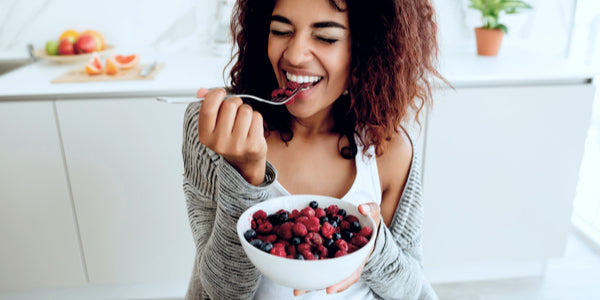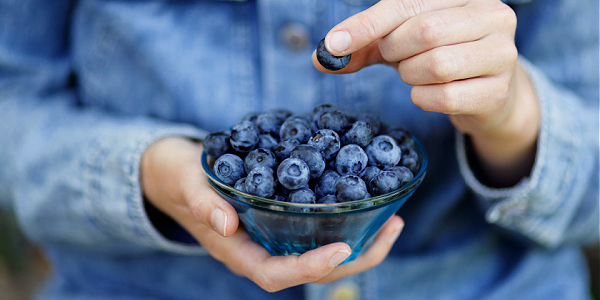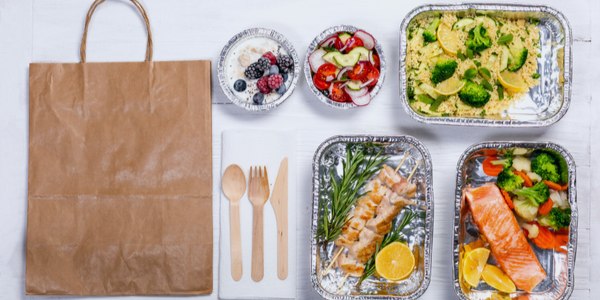
Diet is an essential part of health and survival.
Nutritious foods provide the body with fuel to power through a workout and keep it running efficiently. On the flip side of the coin, chronic disease and poor health are at risk if relying on innutritious products.
While diet is often linked to obesity and related conditions, it likewise can affect skin health.
How Does Your Diet Affect Your Skin?
The foods we choose to eat nourish the cells, skin cells included. This can ultimately lead to noticeable and physical outcomes on the skin's surface.
A poor diet can lead to acne and dry skin. But a nutrient-dense diet can keep the skin feeling and looking clear and radiant.
Learn how to get clear skin by increasing or reducing these nutrients and food sources.
What Are the Best Foods for Clear Skin?
The best foods for clear skin are ones rich in nutrients and proven to support skin health. Include more of these nutrients and their respective food sources.
1. Vitamin C
Vitamin C plays a large role in skin health related to its antioxidant and collagen-building properties. Acting as an antioxidant, vitamin C helps to reduce damage from ultraviolet (UV) light exposure, a major risk factor for skin cancer.
Vitamin C also plays a role in collagen production. Collagen is protein that helps maintain the structure of bone, tendon, skin, cartilage and all other connective tissue. A high intake of vitamin C may lead to better skin tone and decrease wrinkles.
Food sources of vitamin C: bell peppers, broccoli, kale, kiwifruits, oranges, spinach, strawberries
2. Beta Carotene & Vitamin A
Beta carotene is a red, orange, and yellow pigment naturally sourced from plants such as fruits and vegetables. It is converted to vitamin A in the body, which is an essential vitamin.
Vitamin A can also be known as retinol and retinoid, commonly seen on the outside of skin and acne products. Long-term topical use results in significant improvements in fine wrinkles, roughness, and darkening of skin or nails.
Consuming vitamin A sources has been linked to improved wound healing. A deficiency in vitamin A is correlated with poor wound healing as well.
Food sources of vitamin A: cantaloupes, carrots, sweet potatoes, tomatoes, winter squash
3. Protein
Protein is a building block for muscle, skin, and cartilage and necessary for wound healing. With increasing age comes a decreasing ability for proper wound healing related to age-related body changes.
Zinc, a mineral oftentimes found in animal proteins, also plays a role in wound healing. Lysine and proline, two amino acids found in protein, help to promote collagen synthesis as well.
Food sources of protein: chicken, eggs, fish, Greek yogurt, quinoa, sirloin, turkey chicken
4. Zinc
Like mentioned above in protein, zinc has a profound role in wound healing. Zinc also has an important role in apoptosis, or cell death.
Common signs and symptoms of a zinc deficiency may cause dry and scaling skin. Acne may also be a consequence of a diet low in zinc.
Food sources of zinc: beef, cashews, cheddar cheese, dark meats of chicken and turkey, milk, pork
5. Omega-3 Fatty Acids
An omega-3 fatty acid (FA) is a type of "good fat" that can actually contribute to good heart health. Although admired for their role in the reduction of heart disease, omega-3 fatty acids have been linked to healthy skin.
In an article review published in Experimental Dermatology, omega‐3 fatty acids may protect the skin from sun damage.
Food sources of omega-3 fatty acids: flaxseed, halibut, olive oil, salmon, tuna, walnuts
6. Polyphenols
Polyphenols are powerful antioxidants in a wide variety of plant-based foods. Evidence also suggests polyphenols may improve cell survival and prevent tumor growth.
Like vitamin C, polyphenols may defend against UV radiation, a major risk factor for most skin cancers.
Food sources of polyphenols: apples, beans, berries, broccoli, cherries, dark chocolate, garlic, onions, red wine, tea, walnuts
7. Selenium
Linus Pauling Institute reviews selenium is present in the cells of the skin and protects them from the harmful effects caused by UVR and free radicals.
They also forewarn selenium deficiency is linked to an increased risk of skin cancer and imbalances.
Food sources of selenium: barley, beef, brazil nuts, mushrooms, mussels, salmon, sunflower seeds
8. Collagen
A published in Skin Pharmacology and Physiology found improvements in skin elasticity, moisture, and evaporation.
Another study concluded collagen-containing nutritional drinks can significantly improve wrinkle depth, elasticity, and hydration of the skin.
Food sources of collagen: bone broth and animal proteins
What Are the Worst Foods for Your Skin?
In addition to increasing more nutrient-dense foods identified above, consider lowering the intake of the worst foods for skin.
Common culprits for oily, dry, acne-prone, and other skin conditions often include the foods detailed below.
1. Sweet Treats
Sweet treats and other products rich in added sugars can speed up aging through glycation. This is a process in which sugar mixes with protein and fat to form molecules. It is thought to damage skin collagen and elastin.
The American Heart Disease recommends no more than 38 and 25 grams of sugar per day for men and women, respectively. Along with reducing obvious sugar sources, watch out for hidden sugars often listed as corn syrup, sucrose, and fructose.
2. White Breads
White breads and other refined products, including white pasta and rice, can compromise skin health. This is because they are high on the glycemic index.
High-glycemic foods can spike blood sugar levels, especially if not balanced with a protein or healthy fat source. Researchers speculate these spikes can trigger acne, though a low-glycemic diet may lead to clearer skin.
3. Dairy Products
Milk and dairy products may be an underlying culprit of acne, though the reason being is still put into question.
Researchers speculate hormones in dairy may cause inflammation, thus leading to clogged pores and acne.
4. Alcoholic Beverages
Alcohol is a diuretic and can cause dehydration and breakouts, along with interrupting sleep cycles. Chronic and excessive use of alcohol may cause premature wrinkles and increase the risk of age-related chronic diseases.
Males are encouraged to drink no more than two alcoholic servings a day. Women are limited to one serving daily.
How to Get Glowing Skin Naturally
Though excellent skin foods noted above, skin health should not be limited to the list. Ultimately, the wellbeing of skin is optimized by a complete, healthy lifestyle.
Read on for bonus healthy skin tips for face and skin health beyond a beauty routine.
1. Eat More High-Quality Foods
A high-quality diet filled with whole grains, produce, lean protein, and healthy fat offers the body anti-aging nutrients.
Limit the intake of processed foods laden in added sugar, refined flour, unhealthy oils, and salt.
2. Ensure Proper Hydration
Proper hydration can reduce the signs of aging, as skin can become dry, scaly, and sunken in without adequate water intake. When hydrated, though, water offers glow to skin and flushes out waste products that may be harmful.
Aim to drink more water and at least 64 ounces each day, especially on hot days and if exercising.
3. Exercise on a Regular Basis
Physical activity is an integral part of healthy living, also playing a large role in the fight against aging. In fact, exercise can lower oxidative stress, the toxic condition associated with early aging and the onset of age-related conditions.
The American Heart Association encourages individuals to be active at least 150 minutes each week. Include two to three weight training sessions to maximize the benefits of exercise as well.
4. Smoke Cessation
Smoking can dramatically compromise overall health, including speeding up the aging process and causing wrinkles and a dull complexion.
Mitigate such risks and fight aging by learning how to quit smoking.
5. Obtain Sufficient Sleep
Short-term effects of lack of sleep can lead to dark and puffy eyes. The lasting effects of inadequate sleep may accelerate the process of aging.
According to a study commissioned by Estée Lauder, sleep deprivation increases the signs of skin aging. Inadequate sleep can also plummet energy levels and cause hormones to go haywire, which may further accelerate the process of aging.
The National Sleep Foundation encourages seven to nine hours of sleep on a regular basis to lessen such risks.
6. Manage Stress
Chronic stress can be extremely harmful to health. But rather than feeding emotions with food, pouring out alcohol, or other harmful practices, practice healthy stress-relieving techniques.
The practices of yoga, meditation, and mindfulness can naturally reduce stress. Embracing a total lifestyle change filled with a nutritious diet, regular exercise, and adequate sleep.
7. Use Sunscreens and Skin Moisturizes
Whether spending a day at the beach or running errands around town, sun protection is essential on a daily basis.
Protect from skin cancer and aging with a broad-spectrum sunscreen that is SPF 30 (or higher) and water-resistant. Apply an ounce of sunscreen 30 minutes prior to sun exposure and every two to four hours of outdoor activity.
Use sunglasses, too, to protect from the ultraviolet (UV) rays and lower the risks of cataracts, macular degeneration, and pterygium. According to the National Eye Institute (NEI), look for sunglasses that block out 99 to 100 percent of UVA and UVB radiation.
Taken together, a skincare routine is much more than applying facial creams. It involves considering all lifestyle factors, including those diet to diet.
References:
Can the right diet get rid of acne? https://www.aad.org/diet.
Linus Pauling. https://lpi.oregonstate.edu/mic/health-disease/skin-health/minerals







